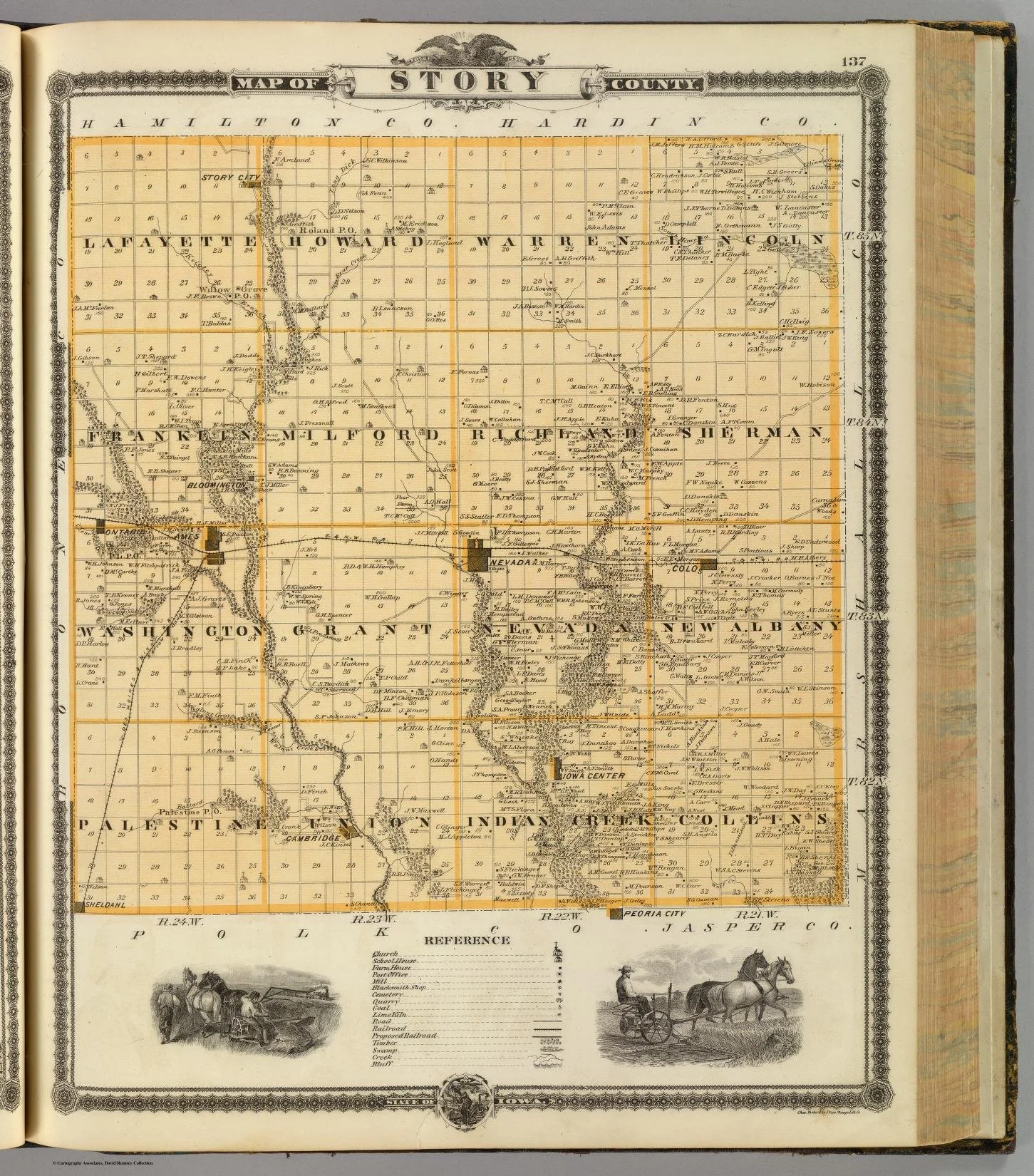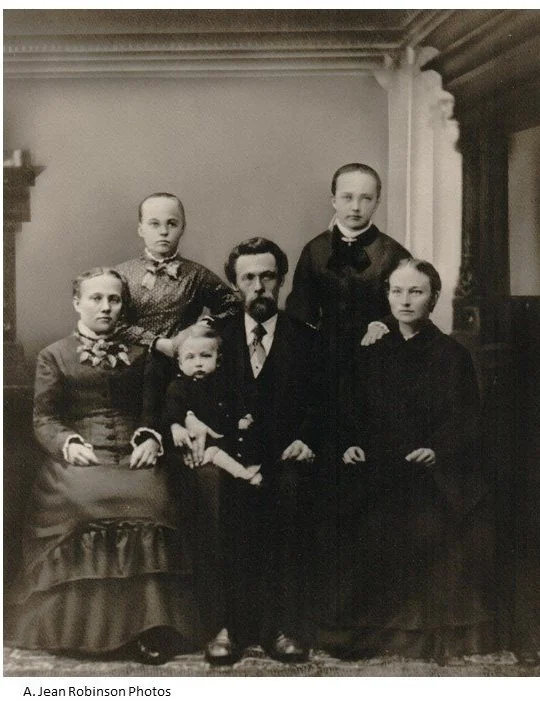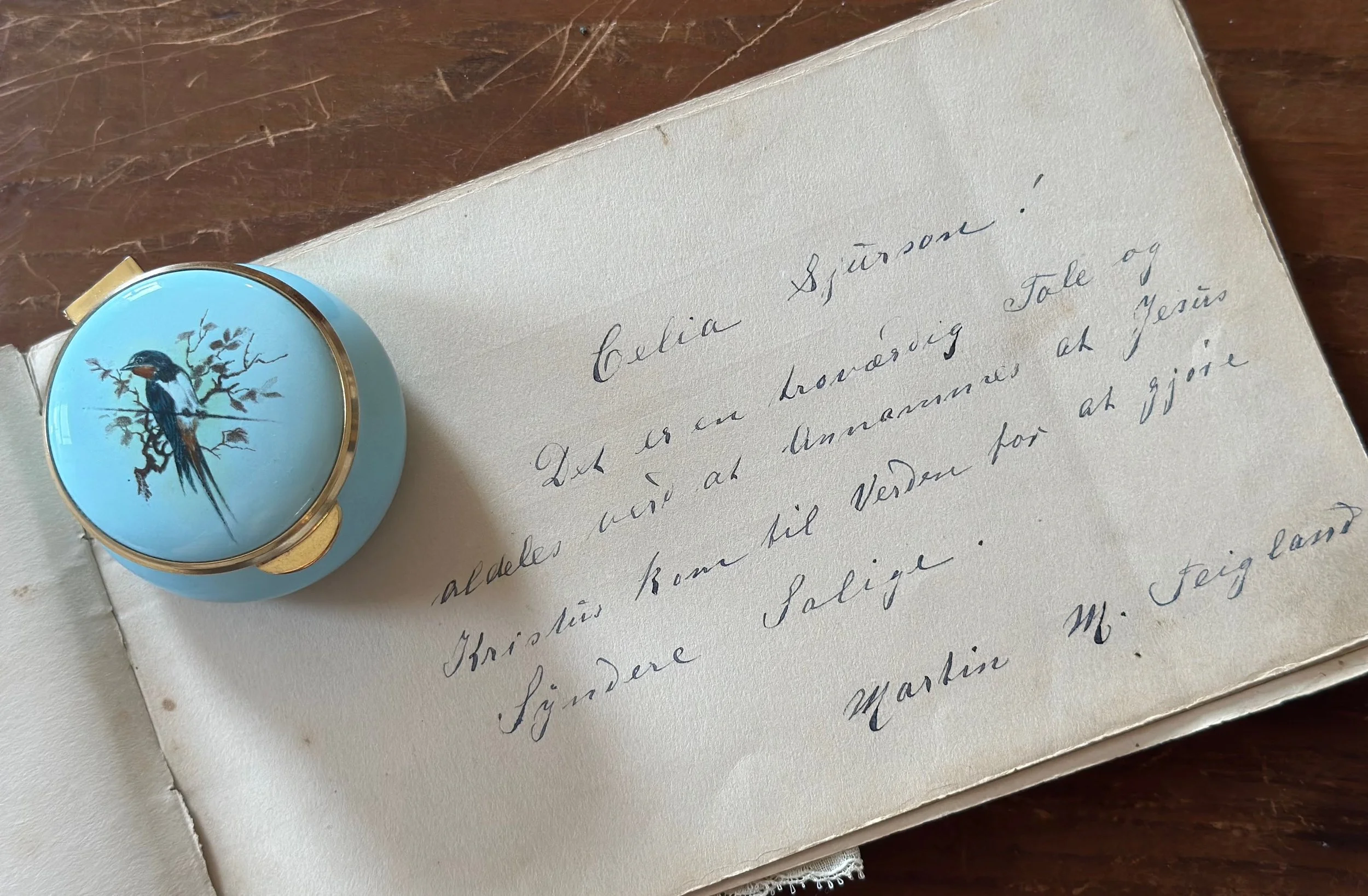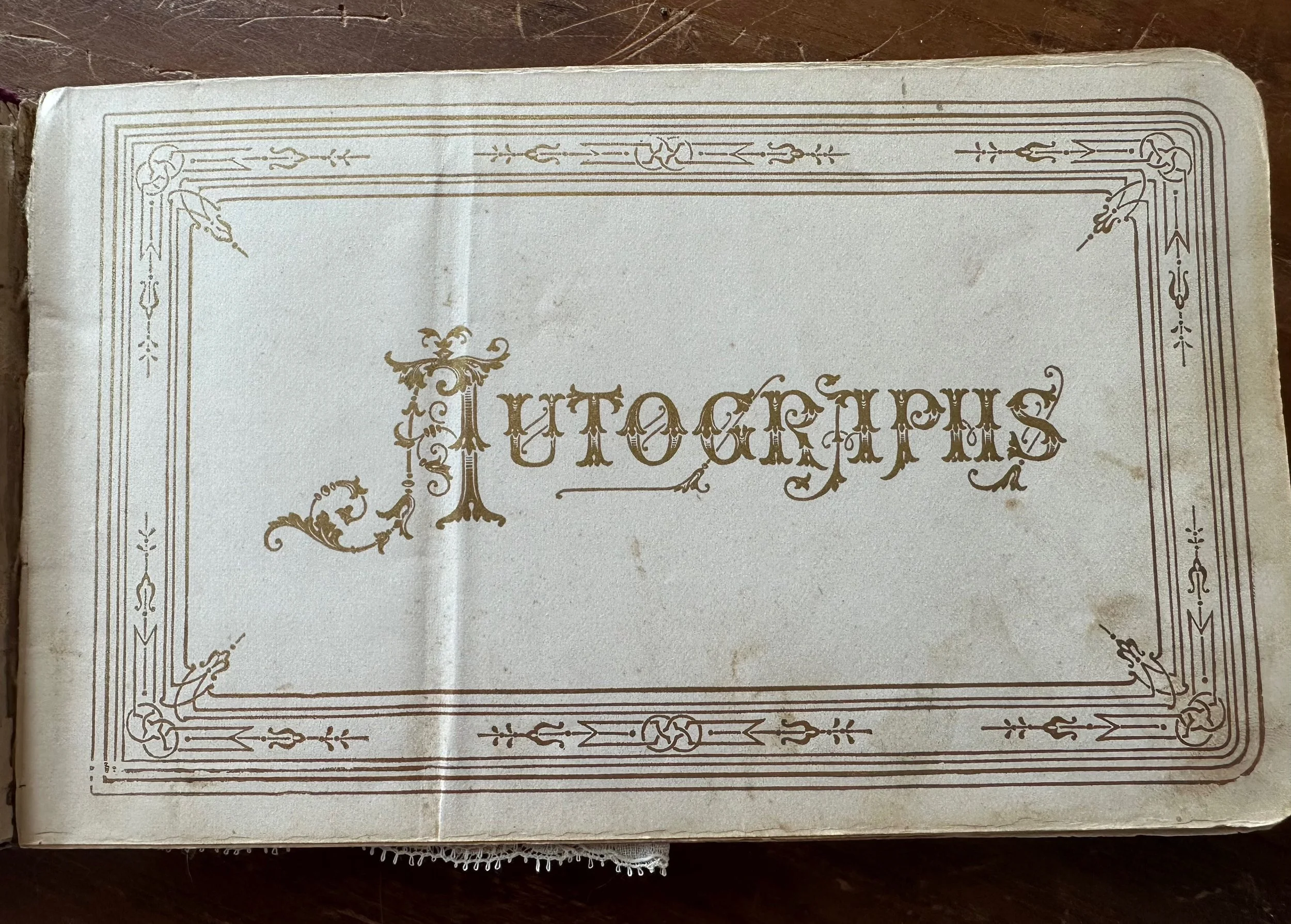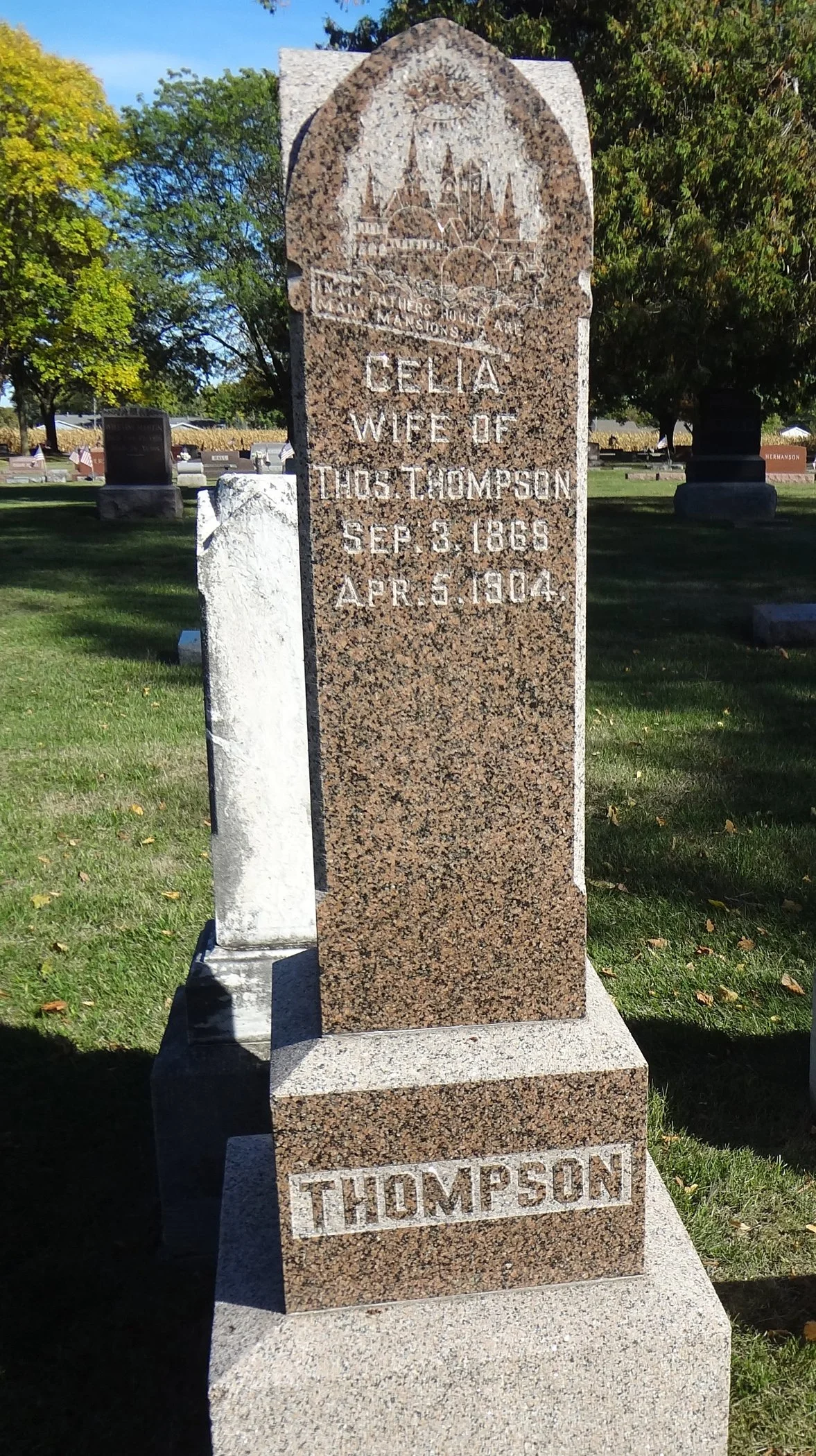Celia Sjurson
Celia had her autograph book in Story City, Iowa in 1899. She was the youngest child of Norwegian immigrants who came to Iowa to farm. She later married Thomas Thompson and had four children, but she died young at the age of 35.
On one warm August afternoon, my husband and I decided that we would go to an antique store in the small town next to ours. I wanted to look for an antique ladder to display quilts and I’m always on the lookout for antique handkerchiefs. This antique store is deceptively huge. From the outside, it looks like a large, rectangular, and unremarkable steel-sided building, but inside, it’s made up of rooms that lead to more rooms that lead to more rooms filled from floor to ceiling with stuff. As you browse items from various vendors, you turn right and then left and then right again, as hallways lead to huge rooms that lead to more hallways.
After not finding any of the things I was looking for, we asked the women running the store if they knew of any diaries hiding amongst the stacks and vendor stalls. I didn’t have high hopes because it wasn’t possible for these two women to have every item in this place memorized, but to my surprise, they ran away into the building’s recesses and came back with a few items. The diaries that they brought were all written by men (not the focus of this project), but they also brought out this sweet little autograph book. All of the inscriptions were to “Celia” and many included the town that we were in at the time in the signatures- Story City, Iowa. I was in love, of course, so I asked the kind ladies to wrap it up, along with this cute blue pillbox. I’m a sucker for anything with barn swallows on it. That trip to the antique mall to pass a summer afternoon introduced me to Celia Sjurson and her story, in which she lived just down the road from where I lived then and roughly 156 years before me in time.
Introduction
Before colonists arrived in the area, there were several Indigenous peoples that lived on the land that is now the state of Iowa. The area was home to Caddoan-speaking tribes including the Pawnee, Algonquian-speaking tribes including the Meskwaki, Sauk, and Illinois, and Iroquian-speaking tribes including the Potawatomi, Ojibwe, and Odawa. Additionally, Southern Plains tribes such as the Apache and Comanche traveled through the area often. Today, there are three federally recognized tribes in Iowa- the Omaha Tribe of Nebraska, the Sac and Fox Tribe of the Mississippi in Iowa, and the Winnebago Tribe of Nebraska, although federal recognition is just one of many (and for reasons, often not the best) ways to recognize current or traditional rights to land.
Celia Sjurson was born on September 3rd, 1868 in Hamilton County, Iowa. She was the youngest daughter of Thor (1832-1899) and Karen (Ranertsdatter, 1835-1928), both of whom were Norwegian immigrants. They arrived in the United States in 1861 to farm.
Story County, Iowa became a focal point in the immigration of Norwegian immigrants to the United States before the Civil War. In one historical record from 1955 from the Iowa Historical Society, the author referred to the area as the “great Norwegian settlement,” and included Story, Hamilton, Hardin, Polk, and Boone Counties in that area. The immigrants started their migration around 1825 and first settled in northern New York State. As people continued to move west in search of affordable and farmable land, there would be settlements in northern Illinois by the 1850s, and then in northern Iowa, southern Minnesota, and even a finger into the Red River valley of North Dakota by the 1860s. The Civil War slowed and even halted immigration soon after that.
Most of these immigrants were farmers from rural areas in southwestern Norway, and were looking for favorable land in the US to farm. These families depended on each other to build their farms, families, and communities and to fend for themselves on the frontier; they spoke the same language, established Lutheran churches to attend together, and built towns and businesses slowly as the railroads were built through the area. The influence of this heritage is still alive in this area today. I mainly notice this in the multitude of small Lutheran churches in each of the rural towns and the kinds of cookies and pastries available in the bakeries :)
The Autograph Book
Celia began collecting signatures in her autograph book on November 15th, 1886, when she was 18 years old. Celia’s book contains entries from family and friends and has entries spanning the years of 1886 to 1900. Her sister, Sarah, signed it and so did Sarah’s husband, Thomas. There are entries from her school friends and cousins too. Two of the entries are in Norwegian, reflecting Celia’s heritage and the heritage of these folks around her at the time. In addition to themes of friendship, remembrance, and well-wishes, there are also religious themes throughout including psalms. The entries aren’t in chronological order; it seems that people just flipped open to any empty page when Celia asked them to sign instead of going in order. There are 19 entries in all.
Autograph books (also known as autograph albums, memory albums, or friendship albums) have a fascinating origin and history in the US. The first true autograph books appeared in German- and Dutch-speaking regions of Europe around the middle of the 16th century. They were then known as an album amicorum (“book of friends”) or stammbuch (“friendship book”), and there are examples dating back to 1545. By the end of that century, they were common in Germany among students at universities to capture the signatures of classmates and professors at graduation. Educated men would keep their autograph books for years for both their sentimental and networking value, since they proved one’s scholarly credentials. The popularity of autograph books rose and fell in the academic community over the next few centuries, particularly after the ability to mass produce books became available, making it possible to document one’s scholarly credentials in other ways. The cultural beginnings of the autograph book is why we still sign school yearbooks today.
There was a resurgence of popularity for autograph books in the 18th century in Germany, but this time it was among the middle class and both men and women participated. Middle class German immigrants brought the tradition to America in the late 18th century, and autograph books’ popularity peaked in the US around the Civil War. After that, they remained a fad among young women for some time.
The entries in autograph books were often more than just the signatures of family, friends, and classmates. They functioned as address books and genealogical records, and had sentimental value too, of course. They often included poems, drawings, and folk sayings that scholars have called “folk literature.” The poems were sometimes funny and sometimes sweet, often with themes of good fortune, friendship, and remembrance, and could be found in magazines so that readers could memorize and repeat them. The autograph entries also sometimes included beautiful calligraphy, drawings, and stickers that the owner would paste on the pages.
There was another resurgence of autograph book popularities in the 1920’s, and their popularity has declined since then… unless you were a child that attended Disney World in the 1990’s… then, autograph books were cool again!
In this unique case of an autograph book, this piece of personal ephemera doesn’t contain an important thing that all other diaries do- the woman’s perspective! In Celia’s case, we don’t have her words, her voice, and her handwriting to get to know her. Instead, we have the historical record, as usual, and the inscriptions from important people in her life. Instead of having her words, we have the words that these people wanted to leave her with in perpetuity. In this case, because this little book has been preserved through time, the wishes for good fortune, remembrance, and friendship live on instead of Celia’s words.
Usually when I study a diary, I transcribe the whole thing and post that typed transcript on each woman’s page. I do this for a few reasons- as a researcher by trade, I find it useful to have a transcript to work from while I do my research. I also like to preserve each woman’s exact words for history’s sake. These diaries are historical texts with valuable information about each woman’s lived experiences. In Celia’s case, though, the medium of an autograph book is different. These artifacts have a written component to them, obviously, but I would argue that they are a visual medium more than anything. They are beautiful objects (I think all the diaries are aesthetically beautiful, though!) and care was taken by the owner and the people that made the entries to make them visually pleasing. The penmanship, drawings, and stickers are integral to what they are. I have transcribed the entries and these are available in Celia’s Transcript page, but the images here are also important to understand the book itself.
Like others, Sarah includes religious themes, but she also gives us a sweet glimpse into their family life. Her reference to “good times” together and their “dear parents” makes me think that they had a happy childhood together. Sarah’s husband, Tom, also left an inscription next to his wife’s.
Next, on November 15th, 1886, Anna Britron wrote to Celia in Norwegian and English,
Friend Celia,
Nyd soo mange gange held som du har Dyder i din Sjal sau bliver du vert Lykelg jeg Rarr ikke bedre onske dig
Your Friend, Anna Britron
Story City Iowa, Nov the 15 1886
In English, this translates to, “Enjoy so many times luck as you have virtues. I hope you'll be happy, I can't wish you better.”
Celia was the last of the four children in her family, all of whom were girls. The first born was Malinda (1859-1945), who was born in Norway and made the journey with her parents to the US in 1861. She married Jens Skorpen (1850-1939) in 1878 and, at the time of the autograph book, they lived close by in Hamilton County as well. By the time we meet Celia, Malinda has already started her large family with Jens, who was a farmer; they would eventually have 11 children together. The next sibling was Caroline. She was born in Illinois, reflecting the historical accounts of the path that Norwegian immigrants took west. She married Samuel Larson (1848-1927) in 1880 and also lived close by in Randall, Iowa, when we meet Celia. She, like Malinda, also started her large family quickly after her marriage and has already had a few of her eventual 6 children by the time Celia has her autograph book. The third daughter was Sarah (1864-1950). She was also born in Illinois and was newly married to Thomas Quam (1859-1950) when we meet Celia. Celia was the fourth and last child in the family and was born in Hamilton County, Iowa. In the state census of 1885, Thor, Karen, Sarah, and Celia are living together on their farm. Soon after that, Celia began collecting inscriptions in her autograph book, so let’s meet her there!
(Photo: Back: Celia and Caroline; Front: Sarah, Jens, Malinda, and young Halvor (Malinda and Jen’s son) in about 1880. This is the only photo I have of Celia.)
Let’s take a look at a few of the notable entries in the book. Celia’s older sister, Sarah, signed the book on February 17th, 1889. Unlike most of the entries, Sarah’s wasn’t a poem or scripted response. She wrote a few lines from her heart to her younger sister.
Dearest Sister,
Long have we been together but when we have to move away from home let us remember the good times we have had together with our dear parents,. This life is short but may we live such that after death we must inherit the kingdom of heaven.
Your sister,
Sarah Quam
Story City Feb 17th. 89
Lastly, let’s look at some examples of the “folk literature” poems that were often included in these autograph books.
January 6th 1887
Friend Celia,
When sitting all alone, Reflecting on the past, Remember that you have a friend, That will forever last
Your Cousin, W.W. Williams
Havelock Pocahontas County Iowa
Friend Celia:-
May thou my friend be ever blest with friends selected from the best and may whatever be thy lot, I only ask forget me not.
Very Truly your friend, Lizzie Omvig
Story City Ia
Nov 15th 1886
Dear Celia
Round as a ring, That has no end, So is my love to, Thee my friend
Julia Mathre
March 4 1900
Again, we see themes of remembrance and friendship in poems that the authors memorized for just this kind of occasion. In addition to the inscriptions, people would often include pictures or stickers as well. Celia also kept pieces of lace and images within the book, giving the autograph book an additional function; in addition to collecting signatures, it was used to collect keepsakes of hers as well.
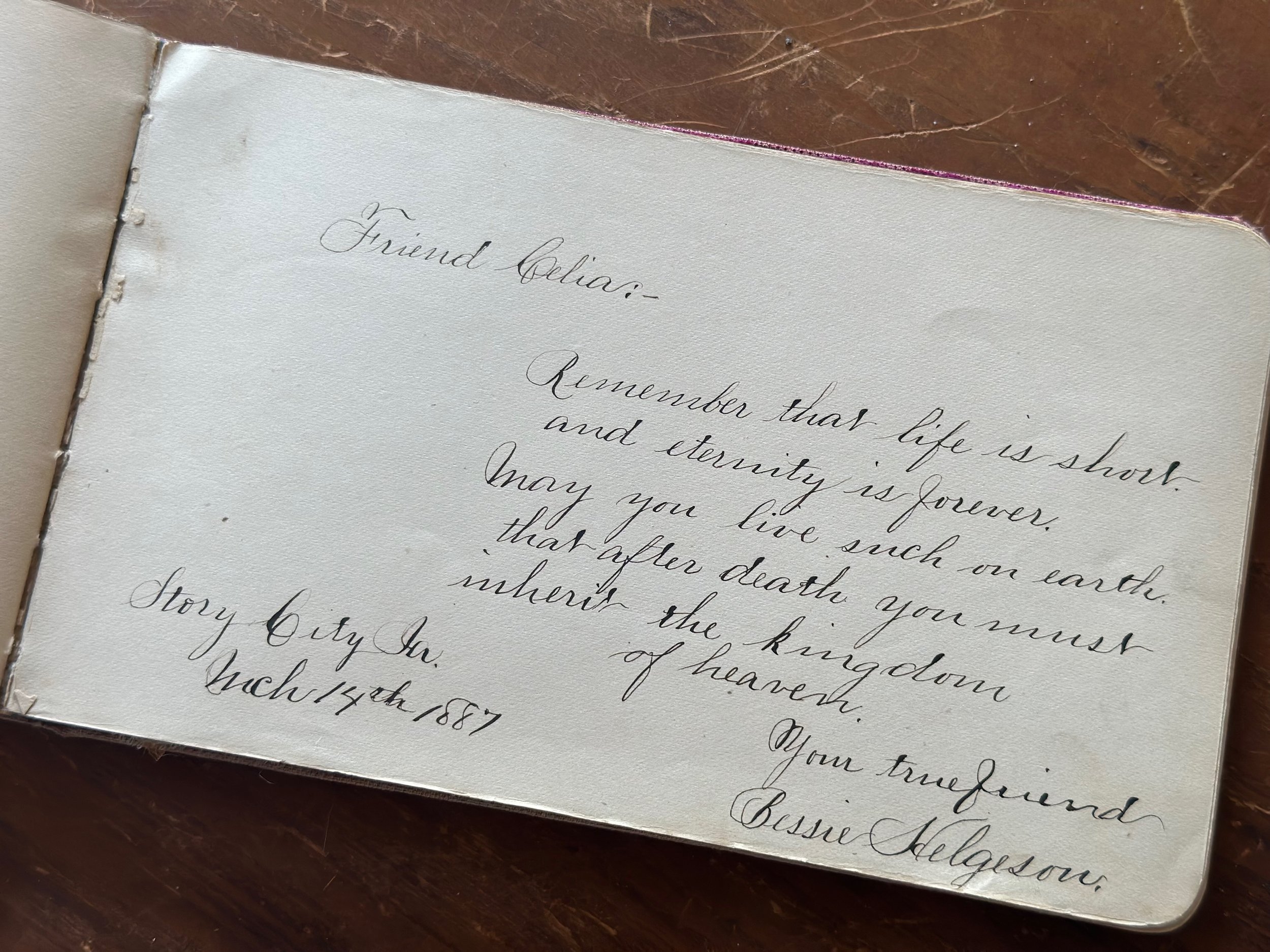
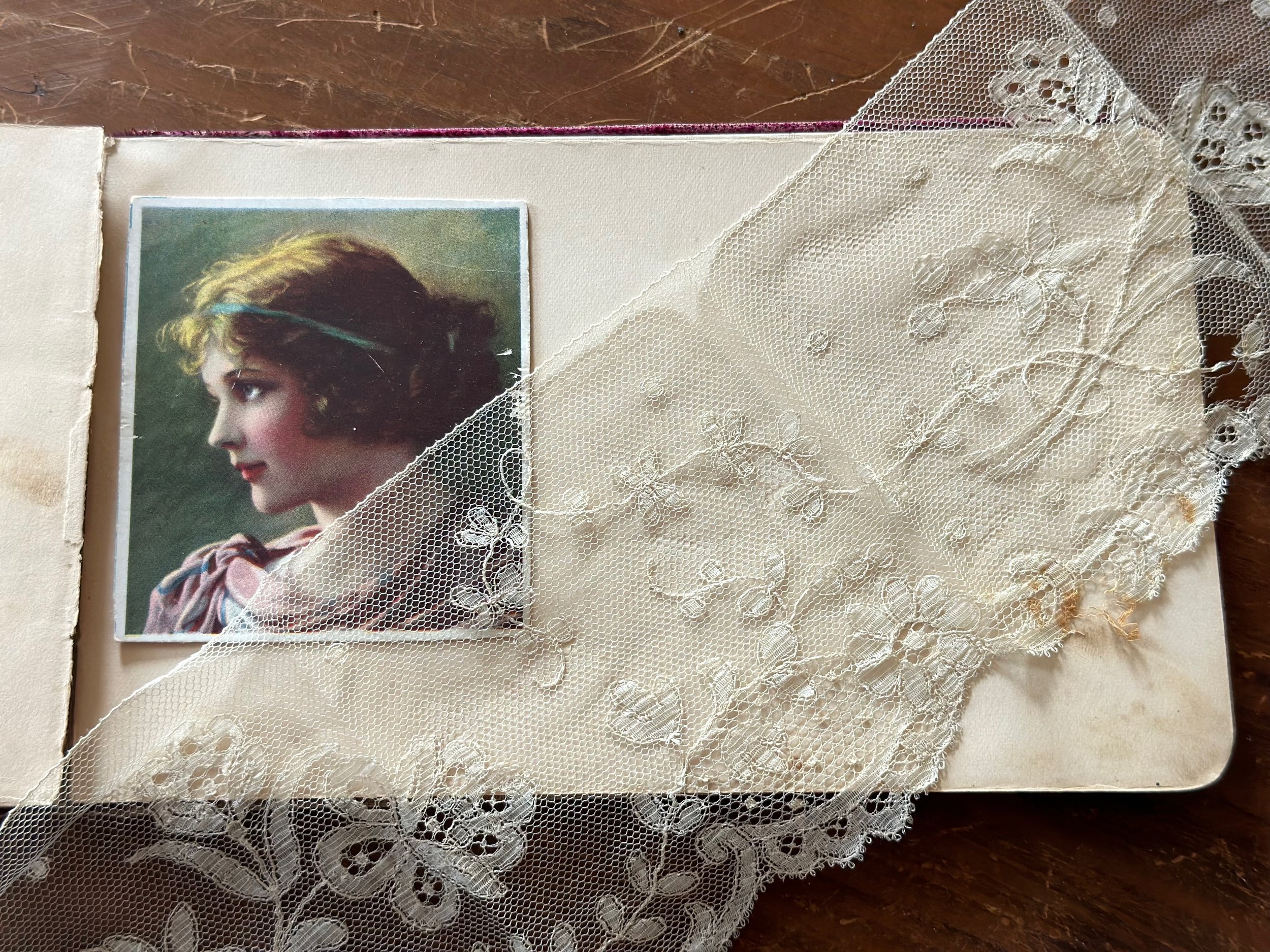


What a beautiful example of girlhood! I think that this autograph book is important for so many historical reasons- it perfectly summarizes the history of autographs books, and gives us a glimpse into an immigrant story that also perfectly summarizes the history of Norwegian immigration to the US, but it also shines a light onto aspects of girlhood that seem to transcend time. Ladies, who among us did not have an autograph book or a sticker album? I had multiples of both! Who among us didn’t relish the last day of the school year when we were able to pass our yearbooks around to collect our friends’ signatures? To this day, I still have my middle school and high school yearbooks, despite the years removed we are and the number of cross-country moves they have been through. Celia was just 18 and entering adulthood when she began her autograph book, full of sweet messages, stickers, and treasured keepsakes, just as so many young girls and women have collected through time.
After
Not long after Celia began her autograph book, she was married to Thomas Egerskog (1857-1932) on December 6th, 1890 at the age of 22 years old. Thomas was born in Norway in June of 1857. It isn’t clear what year he immigrated to the US, since the dates on the 1900, 1920, and 1930 censuses vary, but it was sometime before 1876. He was a farmer in Hamilton County, so he and Celia probably ran into each other in their tight knit Norwegian community. Thomas’ name also varies in documents- after he immigrated, he was often referred to by the surname Thompson, especially on official documents like the census and their marriage license. I assume that Thomas chose to go by a more familiar name than Egerskog after arriving in the US? I’m not sure because I can’t find specific information about this inconsistency or name change, but I am sure that Thomas Egerskog and Thomas Thompson are the same person!
Celia and Thomas wasted no time starting their family! She gave birth to their daughter, Mabel, just 10 months after their wedding in September of 1891. Later, Sofus was born in 1893, Theodore was born in 1898, and Clarence was born in 1901. During this time, Thomas was farming and Celia was tending to the children and home.
Tragically, Celia’s life was much shorter than expected. On April 5th, 1904, she died at home at the age of 35 years old. Unfortunately, I can’t find the cause of death for Celia. Given her age, I have to wonder if she died in childbirth or from one of the many communicable diseases that were untreatable at the time. Their oldest child, Mabel, was only 12 years old when she lost her mother, making her the only woman in the house.
After Celia’s death, the four children lived with their father for years. Mabel left his home in 1920 when she married Nelson Mathiason. They went on to have three children together; she named her youngest child Celia after her sister in 1923. Mabel died in 1968 in Story City. Sofus remained with his father until Thomas died at the age of 75 in 1932 on their farm. It seems that Sofus took over the farm after his father’s death, fulfilling his role as the eldest son. He never married and listed his sister, Mabel, as his next of kin on his WWII registration card. He died in Story City in 1969 at the age of 75. Theodore and Clarence left Thomas’ home together sometime before 1920, and were living together on a farm in that year’s census. In 1925, Theodore married Blanche Jackson (1906-2002) and they went on to have three children. He continued to farm until he died in 1975 at the age of 76.
The last child, Clarence, also never married. After Theodore was married, Clarence moved into Mabel’s home with her husband and children and was living with them in 1925. Tragically, Clarence died at the age of 34 in 1936. His obituary in the Story City Herald (January 16, 1936, page 3) stated, “A lover of adventure, he spent eight years in traveling in the west. For a time he had an interest in a cafe in Burns, Oregon. The rest of his life was spent in and around Story City. He moved last spring to his farm near Albion. This farm is operated by Charlies Christianson. He died suddenly at Marshalltown Friday, Jan. 3. The body was brought here and the funeral was held Monday afternoon from the home of his sister.”
Celia’s autograph book gave us a lovely story beginning in girlhood, which illustrated an example of the immigrant experience, and gave us a glimpse into the farming frontiers of the US. She lived in central Iowa among her countrymen, and created a farming family which she tragically didn’t get to experience for long. I’m grateful to have seen the countryside through her story and to keep this darling autograph book safe for her.

